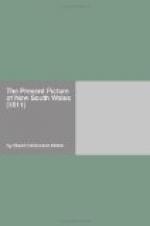The Koolah, or Sloth, a singular animal of the Opossum species, having a false belly, was found by the natives, and brought into the town alive, on the 10th of August, 1803. This is a very singular animal; for when it ascends a tree, at which it is astonishingly expert, it will never quit it until it has cleared it of its leaves. It is mostly found in the mountains and deep ravines to the southward and northward of Broken Bay, and the natives instantly discover its concealment by observing the leaves of the Gum-tree eaten off, this being the tree which it usually selects. It is astonishingly indolent, and is uniformly found with a companion, locked in each other’s arms, as it were. Its claws are very strong, and are of material service in assisting it to climb trees; its length from eighteen inches to two feet; and two stuffed specimens are to be seen in Mr. Bullock’s Museum.
Latterly also, a species of the Hyena has been found at Port Dalrymple, which is extremely ferocious in appearance, has a remarkably large mouth, is striped all over, very strongly limbed, and its claws strong, long, and sharp. This animal is likewise of the Opossum kind, having, like the generality of subjects found in New Holland, a false belly. Notwithstanding its apparent ferocity, it has never yet ventured to attack any human being, but has confined its ravages to sheep and poultry, amongst which it has committed frequent and very serious depredations. No one of these animals, I believe, has hitherto been brought over to England, either alive or dead, since their native fierceness renders them less easy of capture than the Koolah.
Flying Mice are likewise found, in considerable numbers, in this country, of a very handsome appearance, and also of the Opossum species. The tail of this interesting little animal resembles a feather; its belly is white, and its back brown; and it is covered with a down as soft as satin. It flies like an Opossum. This subject is much regarded for its beauty.
The Porcupine Ant-eaters are found in most parts of the country, and are esteemed very good eating; they burrow in the earth, and have a tongue of remarkable length, which they put out of their mouth, and the ants immediately crowd upon it, as if lured by some particular attraction, and when it appears to be pretty well covered, it is drawn in with rapidity, and the insects are expeditiously swallowed.—Stuffed specimens of these are also to be seen in the Museum of Mr. Bullock.
Black and white mottled Fern tree was found at the head of Lane Cove, by Colonel Paterson, about five years since; but it does not run to any considerable size. It is esteemed a very handsome wood for the purposes of veneering.
The Spice tree has also been found to the southward: It is a very strong aromatic, and possesses a more pungent quality than pepper. This tree produces a berry, which, as well as the bark, is of a very powerful spicy nature.




